Soy Isoflavones Induce Cell Death by Copper-Mediated Mechanism: Understanding Its Anticancer Properties
- PMID: 37049690
- PMCID: PMC10095714
- DOI: 10.3390/molecules28072925
Soy Isoflavones Induce Cell Death by Copper-Mediated Mechanism: Understanding Its Anticancer Properties
Abstract
Cancer incidence varies around the globe, implying a relationship between food and cancer risk. Plant polyphenols are a class of secondary metabolites that have recently attracted attention as possible anticancer agents. The subclass of polyphenols, known as isoflavones, includes genistein and daidzein, which are present in soybeans and are regarded as potent chemopreventive agents. According to epidemiological studies, those who eat soy have a lower risk of developing certain cancers. Several mechanisms for the anticancer effects of isoflavones have been proposed, but none are conclusive. We show that isoflavones suppress prostate cancer cell growth by mobilizing endogenous copper. The copper-specific chelator neocuproine decreases the apoptotic potential of isoflavones, whereas the iron and zinc chelators desferroxamine mesylate and histidine do not, confirming the role of copper. Reactive oxygen species (ROS) scavengers reduce isoflavone-induced apoptosis in these cells, implying that ROS are cell death effectors. Our research also clearly shows that isoflavones interfere with the expression of the two copper transporter genes, CTR1 and ATP7A, in cancerous cells. Copper levels are widely known to be significantly raised in all malignancies, and we confirm that isoflavones can target endogenous copper, causing prooxidant signaling and, eventually, cell death. These results highlight the importance of copper dynamics within cancer cells and provide new insight into the potential of isoflavones as cancer-fighting nutraceuticals.
Keywords: anticancer; cell death; copper; daidzein; genistein; isoflavones.
Conflict of interest statement
The authors declare no conflict of interest.
Figures

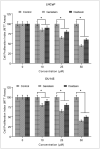
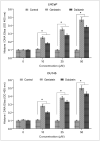
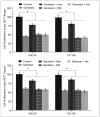
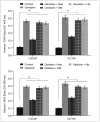
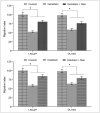
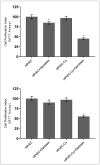
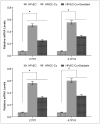
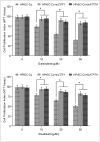

Similar articles
-
Soy isoflavones augment the effect of TRAIL-mediated apoptotic death in prostate cancer cells.Oncol Rep. 2011 Sep;26(3):533-41. doi: 10.3892/or.2011.1332. Epub 2011 May 31. Oncol Rep. 2011. PMID: 21637922
-
Combination of low dose of genistein and daidzein has synergistic preventive effects on isogenic human prostate cancer cells when compared with individual soy isoflavone.Food Chem. 2013 Dec 1;141(3):1923-33. doi: 10.1016/j.foodchem.2013.04.109. Epub 2013 May 9. Food Chem. 2013. PMID: 23870911
-
Soy isoflavone genistein induces cell death in breast cancer cells through mobilization of endogenous copper ions and generation of reactive oxygen species.Mol Nutr Food Res. 2011 Apr;55(4):553-9. doi: 10.1002/mnfr.201000329. Epub 2010 Dec 6. Mol Nutr Food Res. 2011. PMID: 21462322
-
Genistein and daidzein: different molecular effects on prostate cancer.Anticancer Res. 2013 Jan;33(1):39-44. Anticancer Res. 2013. PMID: 23267126 Review.
-
A prooxidant mechanism for the anticancer and chemopreventive properties of plant polyphenols.Curr Drug Targets. 2012 Dec;13(14):1738-49. doi: 10.2174/138945012804545560. Curr Drug Targets. 2012. PMID: 23140285 Review.
Cited by
-
Current Understanding of Polyphenols to Enhance Bioavailability for Better Therapies.Biomedicines. 2023 Jul 24;11(7):2078. doi: 10.3390/biomedicines11072078. Biomedicines. 2023. PMID: 37509717 Free PMC article. Review.
-
Microwave Irradiation as a Powerful Tool for Isolating Isoflavones from Soybean Flour.Molecules. 2024 Oct 2;29(19):4685. doi: 10.3390/molecules29194685. Molecules. 2024. PMID: 39407613 Free PMC article.
-
Cellular and Molecular Mechanisms Modulated by Genistein in Cancer.Int J Mol Sci. 2025 Jan 27;26(3):1114. doi: 10.3390/ijms26031114. Int J Mol Sci. 2025. PMID: 39940882 Free PMC article. Review.
-
Potential Strategies for Overcoming Drug Resistance Pathways Using Propolis and Its Polyphenolic/Flavonoid Compounds in Combination with Chemotherapy and Radiotherapy.Nutrients. 2024 Oct 31;16(21):3741. doi: 10.3390/nu16213741. Nutrients. 2024. PMID: 39519572 Free PMC article. Review.
-
Phytochemicals in Cancer Chemoprevention: Preclinical and Clinical Studies.Cancer Control. 2024 Jan-Dec;31:10732748241302902. doi: 10.1177/10732748241302902. Cancer Control. 2024. PMID: 39629692 Free PMC article. Review.
References
-
- Zubair H., Azim S., Khan H.Y., Ullah M.F., Wu D., Singh A.P., Hadi S.M., Ahmad A. Mobilization of Intracellular Copper by Gossypol and Apogossypolone Leads to Reactive Oxygen Species-Mediated Cell Death: Putative Anticancer Mechanism. Int. J. Mol. Sci. 2016;17:973. doi: 10.3390/ijms17060973. - DOI - PMC - PubMed
-
- Shi M., Gu J., Wu H., Rauf A., Emran T.B., Khan Z., Mitra S., Aljohani A.S.M., Alhumaydhi F.A., Al-Awthan Y.S., et al. Phytochemicals, Nutrition, Metabolism, Bioavailability, and Health Benefits in Lettuce—A Comprehensive Review. Antioxidants. 2022;11:1158. doi: 10.3390/antiox11061158. - DOI - PMC - PubMed
MeSH terms
Substances
Grants and funding
LinkOut - more resources
Full Text Sources
Research Materials

